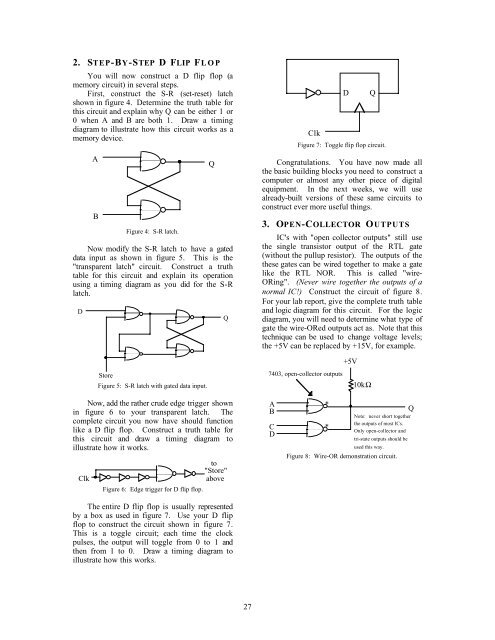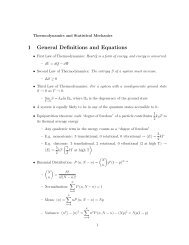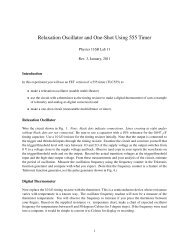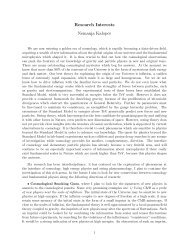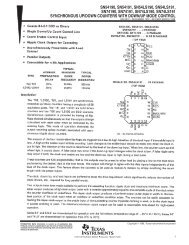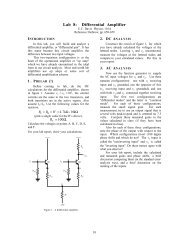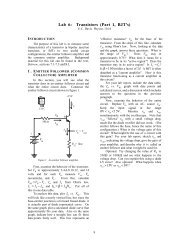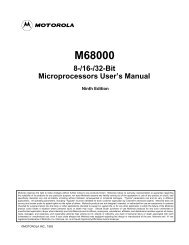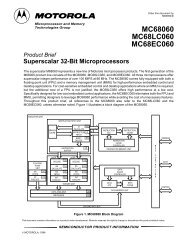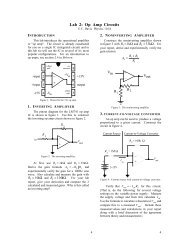Lab 13: Inside Digital ICs - UC Davis
Lab 13: Inside Digital ICs - UC Davis
Lab 13: Inside Digital ICs - UC Davis
Create successful ePaper yourself
Turn your PDF publications into a flip-book with our unique Google optimized e-Paper software.
2. STEP-BY-STEP D FLIP FLOP<br />
You will now construct a D flip flop (a<br />
memory circuit) in several steps.<br />
First, construct the S-R (set-reset) latch<br />
shown in figure 4. Determine the truth table for<br />
this circuit and explain why Q can be either 1 or<br />
0 when A and B are both 1. Draw a timing<br />
diagram to illustrate how this circuit works as a<br />
memory device.<br />
A<br />
B<br />
Figure 4: S-R latch.<br />
Now modify the S-R latch to have a gated<br />
data input as shown in figure 5. This is the<br />
"transparent latch" circuit. Construct a truth<br />
table for this circuit and explain its operation<br />
using a timing diagram as you did for the S-R<br />
latch.<br />
D<br />
Store<br />
Figure 5: S-R latch with gated data input.<br />
Q<br />
Q<br />
D<br />
Q<br />
Clk<br />
Figure 7: Toggle flip flop circuit.<br />
Congratulations. You have now made all<br />
the basic building blocks you need to construct a<br />
computer or almost any other piece of digital<br />
equipment. In the next weeks, we will use<br />
already-built versions of these same circuits to<br />
construct ever more useful things.<br />
3. OPEN-COLLECTOR OUTPUTS<br />
IC's with "open collector outputs" still use<br />
the single transistor output of the RTL gate<br />
(without the pullup resistor). The outputs of the<br />
these gates can be wired together to make a gate<br />
like the RTL NOR. This is called "wire-<br />
ORing". (Never wire together the outputs of a<br />
normal IC!) Construct the circuit of figure 8.<br />
For your lab report, give the complete truth table<br />
and logic diagram for this circuit. For the logic<br />
diagram, you will need to determine what type of<br />
gate the wire-ORed outputs act as. Note that this<br />
technique can be used to change voltage levels;<br />
the +5V can be replaced by +15V, for example.<br />
+5V<br />
7403, open-collector outputs<br />
10kΩ<br />
Now, add the rather crude edge trigger shown<br />
in figure 6 to your transparent latch. The<br />
complete circuit you now have should function<br />
like a D flip flop. Construct a truth table for<br />
this circuit and draw a timing diagram to<br />
illustrate how it works.<br />
Clk<br />
to<br />
"Store"<br />
above<br />
Figure 6: Edge trigger for D flip flop.<br />
The entire D flip flop is usually represented<br />
by a box as used in figure 7. Use your D flip<br />
flop to construct the circuit shown in figure 7.<br />
This is a toggle circuit; each time the clock<br />
pulses, the output will toggle from 0 to 1 and<br />
then from 1 to 0. Draw a timing diagram to<br />
illustrate how this works.<br />
A<br />
B<br />
C<br />
D<br />
*<br />
Note: never short together<br />
the outputs of most <strong>ICs</strong>.<br />
*<br />
Only open-collector and<br />
tri-state outputs should be<br />
used this way.<br />
Figure 8: Wire-OR demonstration circuit.<br />
Q<br />
27


